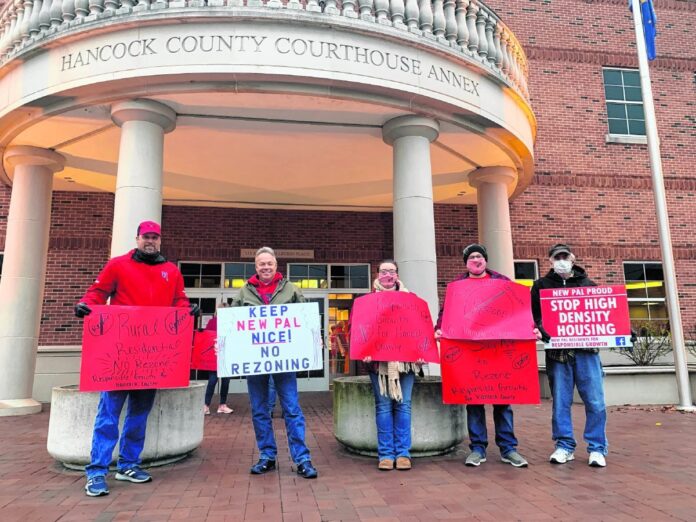
HANCOCK COUNTY — Planning officials are recommending that the Hancock County Commissioners deny a proposed neighborhood near New Palestine.
D.R. Horton, a home builder with headquarters in Arlington, Texas, wants to build 185 single-family houses on 81 acres near the southeast corner of U.S. 52 and County Road 800W. It would be called Fields at Sugar Creek. The developer would also like to establish commercial development north of the proposed neighborhood, along U.S. 52.
The total of 185 homes is down from D.R. Horton’s original proposal of no more than 229 lots for the site, which is just northwest of Schildmeier Village. The developer made the reduction and other changes after its original plans drew opposition from residents in the area. Much of the opposition stemmed from the plan’s standards calling for houses on smaller lots and closer together than what current zoning rules allow.
D.R. Horton wants to rezone much of the site from its current residential zoning to a planned unit development, which would set specific standards the developer and officials agree to.
[sc:text-divider text-divider-title=”Story continues below gallery” ]
Brian Tuohy, a lawyer representing D.R. Horton, went over the revisions at a Hancock County Area Plan Commission meeting earlier this week. He pointed to how the reduction in the number of lots would decrease the neighborhood’s density. The minimum house sizes would exceed that of the current zoning, but lot sizes would be smaller than what’s stated in the existing rules. D.R. Horton also agreed to increase setbacks between homes and streets from its original proposal, although they still fall short of the site’s current zoning classification.
One of the points of contention among opponents are the streets that would connect with those in Schildmeier Village. The developer scrapped those plans, opting instead for pedestrian and bicycle paths extending to the existing neighborhood.
Tuohy said a border between the new neighborhood and existing ones would be made up of a 40-foot buffer with a mound 4 to 6 feet high landscaped with trees.
“We have tried to separate our neighborhood from the adjoining neighborhood,” Tuohy said.
The builder also agreed to use brick in construction and no vinyl siding, said Tuohy, who also said price points would be around $300,000.
Paul Carroll, an attorney representing homeowners’ associations for the Schildmeier Village and Wilmont neighborhoods, said his clients maintain their opposition despite the adjustments, which were made not long before the meeting.
“Our opinion hasn’t changed of the development, although it certainly would’ve been nice to see the changes before today,” Carroll said.
Carroll also said the proposal defies the county’s comprehensive plan, which in its opening refers to the county’s agricultural heritage and the importance of maintaining the rural quality of life.
“It is difficult to square agricultural values and rural qualities of life with the dense subdivision that’s been proposed by way of this PUD (planned unit development),” he said.
D.R. Horton has argued the proposal aligns with the comprehensive plan, as it also delineates a mixed-use corridor along U.S. 52 and calls for low-density suburban residential uses to the south of that corridor.
Deno Webb, president of Schildmeier Village’s homeowners association, said the residents he represents have a vision for the New Palestine area.
“There’s a feel that you see as you start driving into New Pal, and they’re concerned about… the future growth of New Pal as a community that they seek to live in,” he said.
Webb also criticized what he described as hastily made changes to the plan that were not shared by D.R. Horton, adding the first time he saw the revised details was at the plan commission meeting.
“You’ve seen many people up here with their causes through the years where the developer has gone the extra mile to make sure that those residents understood and trusted them,” he told plan commission members. “We don’t understand them, and we don’t trust them, and that’s how we’d just like to leave it.”
Webb’s remarks and others throughout the meeting were met with applause from attendees who packed the room. Many wore red and some held signs that read, “Save our small town” and “Stop high-density housing.” Before the meeting, opponents gathered outside with signs as well.
Brad Armstrong, a plan commission member and county commissioner, shared Webb’s sentiments in his message to D.R. Horton.
“I find it kind of ironic, you, at the last minute got to something that’s reasonably close to where I think people would like to be, but I think to what Deno Webb said — there’s not a lot of trust there when you get there 48 hours before the meeting,” Armstrong said.
Armstrong added that while he represents the area in which the project is proposed, that evening was the first time he had ever met anyone involved in the proposal.
Bill Bolander, a plan commission member and county council member whose district also includes southwestern Hancock County, said the proposal is better than it was but that the late changes made it feel like a “bait-and-switch.”
Mike Dale, executive director of the county plan commission, said he could not support the project either. He said he received a link to a petition with 2,600 opponents’ signatures and 65 emails from opponents.
“I work for the taxpayer, the county taxpayer, and if they feel this strongly against a project then I feel I would need to support their view on this,” Dale said.
The plan commission voted unanimously to send the proposal to the county commissioners with an unfavorable recommendation.
Dale said the matter has not yet been added to the commissioners’ agenda.
[sc:pullout-title pullout-title=”At a glance” ][sc:pullout-text-begin]
Fields at Sugar Creek
- 185 single-family residential lots
- 81 acres
- Southeast corner of U.S. 52 and County Road 800W
Next step: After an unfavorable recommendation from the county plan commission, the proposal now goes to the county commissioners.
[sc:pullout-text-end]




